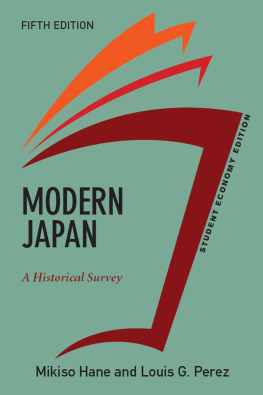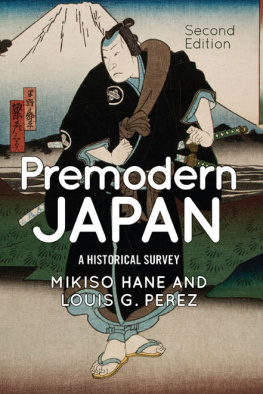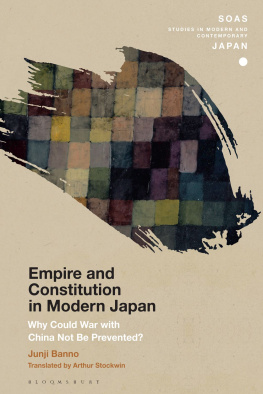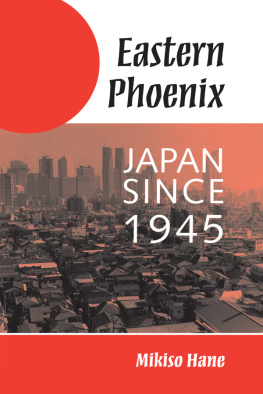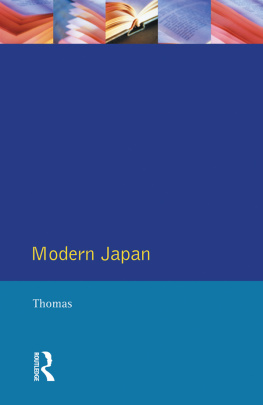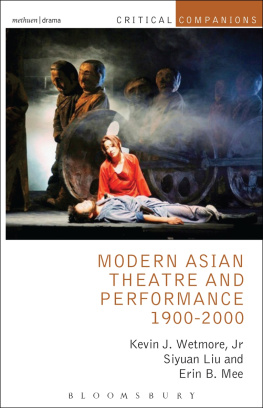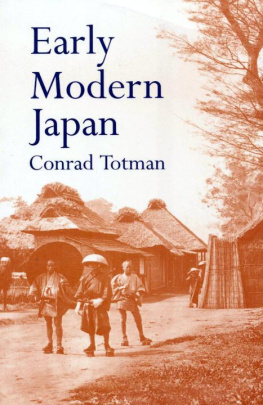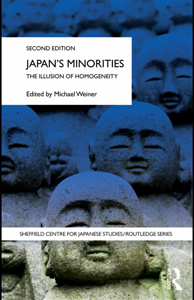First published 2016 by Westview Press
Published 2018 by Routledge
711 Third Avenue, New York, NY 10017, USA
2 Park Square, Milton Park, Abingdon, Oxon OX14 4RN
Routledge is an imprint of the Taylor & Francis Group, an informa business
Copyright 2016 by Taylor & Francis
All rights reserved. No part of this book may be reprinted or reproduced or utilised in any form or by any electronic, mechanical, or other means, now known or hereafter invented, including photocopying and recording, or in any information storage or retrieval system, without permission in writing from the publishers.
Notice:
Product or corporate names may be trademarks or registered trademarks, and are used only for identification and explanation without intent to infringe.
Every effort has been made to secure required permissions for all text, images, maps, and other art reprinted in this volume.
Library of Congress Cataloging-in-Publication Data
Hane, Mikiso.
Modern Japan : a historical survey / Mikiso Hane, Louis G. Perez.5th ed.
p. cm.
Includes bibliographical references and index.
ISBN 978-0-8133-4694-6 (pbk. : alk. paper)ISBN 978-0-8133-4695-3
(e-book) 1. JapanHistory19th century. 2. JapanHistory20th century.
I. Perez, Louis G. II. Title.
DS881.H36 2012
952.025dc23
2012016444
ISBN 13: 978-0-8133-5014-1 (pbk)
PERSONAL NAMES
Japanese and Chinese family names are listed first, followed by the personal name (e.g., Yamagata Aritomo), except when the individual is well-known by the Anglicized version (e.g., I. M. Pei or Akira Iriye).
Similarly, certain historical figures are better known by their Anglicized names than by their actual names (e.g., Chiang Kai-shek is better known than Jiang Jieshi; Sun Yat-sen is better known than Sun Zhongshan). An attempt will be made to use the Pin-yin version but indicate the Anglicized name in parentheses the first time it is used.
PLACE NAMES
The Pin-yin system will be used except when a quotation is made from another source or when the old Wade-Giles system is so familiar that using the new system would seem to be an affectation (e.g., Beijing Duck or the Japanese Guangdong Army).
The quarter-century since Mikiso Hanes first edition of Modern Japan: A Historical Survey was published in 1986 has not been particularly good for Japan. Since then, Japan has slipped from its newly acquired status as the worlds number-one economy to what many consider third place behind the United States and China. The last ten years of the twentieth century and the first ten years of the twenty-first have been justly called the Lost Decades in Japan. The Liberal Democratic Party (LDP), which had ruled Japan since its inception in 1955, encountered a political groundswell that ousted it from power in the early 1990s and cracked it open like an eggshell in the mid-2000s. Leftist political movements coalesced briefly in the 1990s but fell apart shortly and were stymied by other political forces in the 2000s.
The national economy that had soared in the 1980s burst like a childs soap bubble in the 1990s. Japans financial class, which had arrogantly acquired iconic markers of European and American power (e.g., Rockefeller Center in New York City and countless works of art) when Japans land prices skyrocketed in the 1980s, ignominiously sold them off in the 1990s when Tokyo land prices collapsed. Suddenly the Japan Inc. that had smugly preached Japanese quality control to the American automobile industry no longer strutted about as if it really believed that Japan was Number One, as one American academic had claimed a decade before.1
Japan had piously preached world peace by virtue of its Peace Constitution, which eschews war as an extension of diplomacy. In the early 1980s Japans diplomats began a concerted effort to have Japan installed as a permanent member of the United Nations Security Council. Beginning in the early 1990s, however, it sheepishly contributed huge sums to support the United Nations in quixotic military ventures into Bosnia, Iraq (twice!), and Afghanistan. The other members of the Security Council (Great Britain, Russia, France, the United States, and the Peoples Republic of China) firmly reminded Japan that in order to become a permanent member, one had to pledge the nations military forces to staff the UN peace-keeping forces. Because Japans constitution prohibits military forces, Japan could not pledge its Self-Defense Forces to that service.
The smug, self-satisfied Japan of the 1980s was hoist on its own petard in the 1990s and early 2000s. Praised and feted by the world press when it was an economic giant, it now cowered when criticized for its desultory enforcement of its womens rights laws; its treatment of Ainu, zainichi Koreans, and burakumin; and its failure to learn the lessons of its war guilt. These were bitter pills to swallow.
Japan changed dramatically over that quarter-century, but the reasons Miki had in 1986 for writing this textbook have not changed very much. Despite its economic power, Japan remains an enigma for most Americans. College students come to its study remarkably ignorant of Japanese history. The knowledge that they bring to our classes have more to do with samurai chop-socky movies, video games, and anime than with the brief chapter of high school world history that they endured.
The fact that Mikis textbook is now in its fifth edition has much to do with Mikis timeless prose and his abiding sense of humanity. As I wrote in the preface to the fourth edition, I had taken on the task of revising the book with deep humility, but also with a sense of obligation to Miki for having produced a readable history that students could and would actually read. As Jim Huffman eloquently noted in Mikis obituary, Miki had led the way for his American peers in making women, workers, and peasants a serious part of the narrative.2
Many of my colleagues have thanked me for keeping Mikis voice in the foreground of the revised fourth edition. When approached by Lindsey Zahuranec, associate acquisitions editor at Westview Press, with the idea of a new edition, I thought long and hard whether it was necessary. I asked a number of my colleagues, including Roy Hanashiro, Michael Lewis, Betsy Dorn Lublin, and Michael Schneider, and they urged that I do it. None of them said so in so many words, but the tacit understanding was that I update the book but not disturb its essence. I hope that I have done so. I have brought the domestic politics and foreign affairs sections into the current era and added a narrative of the cataclysmic Three Strikes of earthquake, tsunami, and nuclear meltdown of March 2011. The bibliography also has been updated, and new categories added when it seemed appropriate. I was astounded to discover that I have added almost 200 monographs published since the previous edition. Happily, the term post-modern has almost completely disappeared from titles of those new works. I suspect that a decade from now it will have as much relevance as the term Marxian.
I thank the editors at Westview, particularly Lindsey Zahuranec for her patience and assistance with the revision. Also, those friends I have mentioned, and many whom I have not, have helped me tremendously. Several have offered advice or pointed out previous errors. I am grateful to them all. As always, my wife has remained long-suffering and supportive, and I thank her as well.


